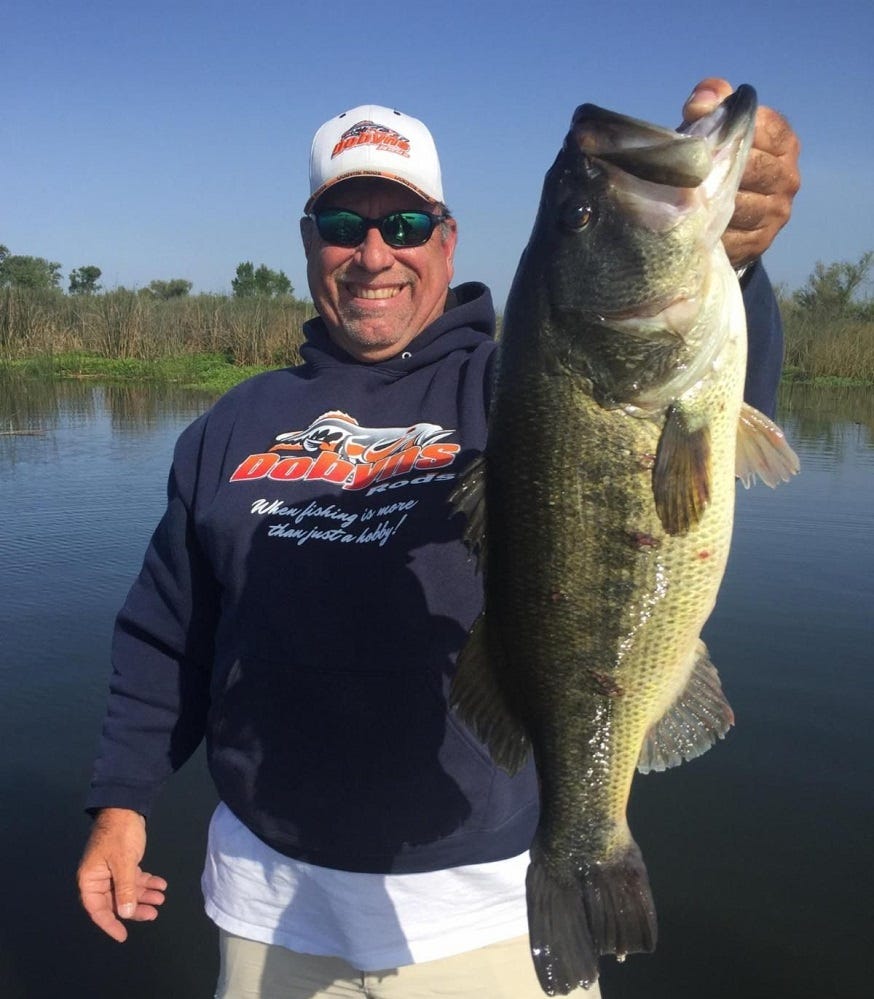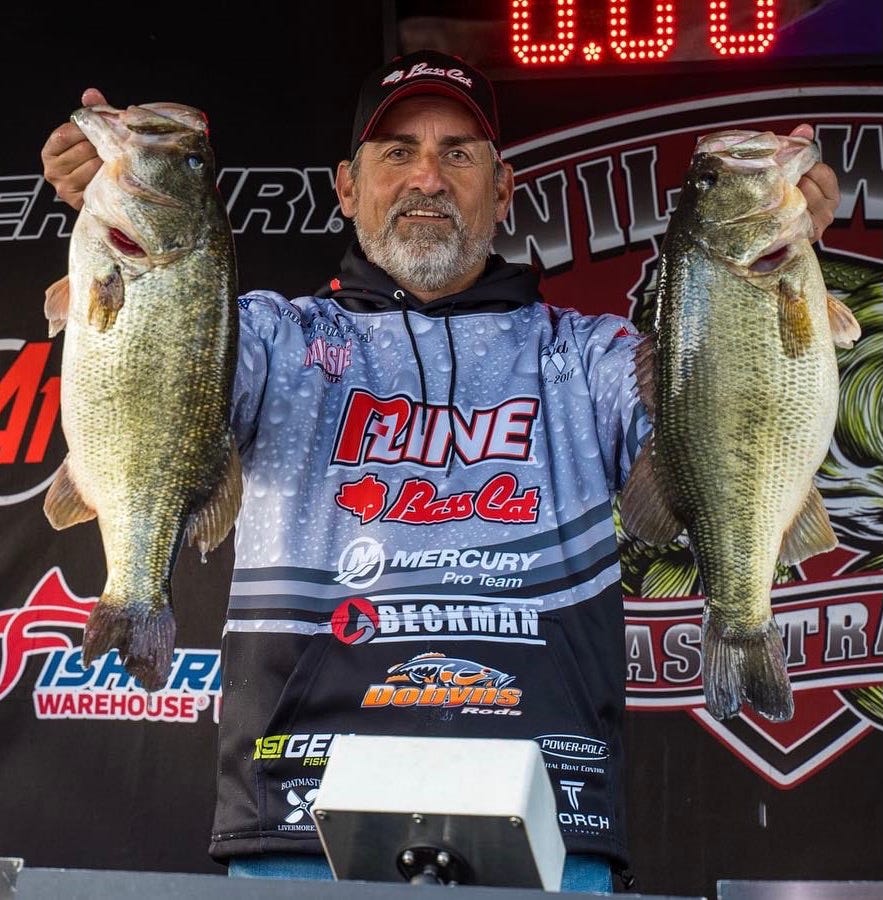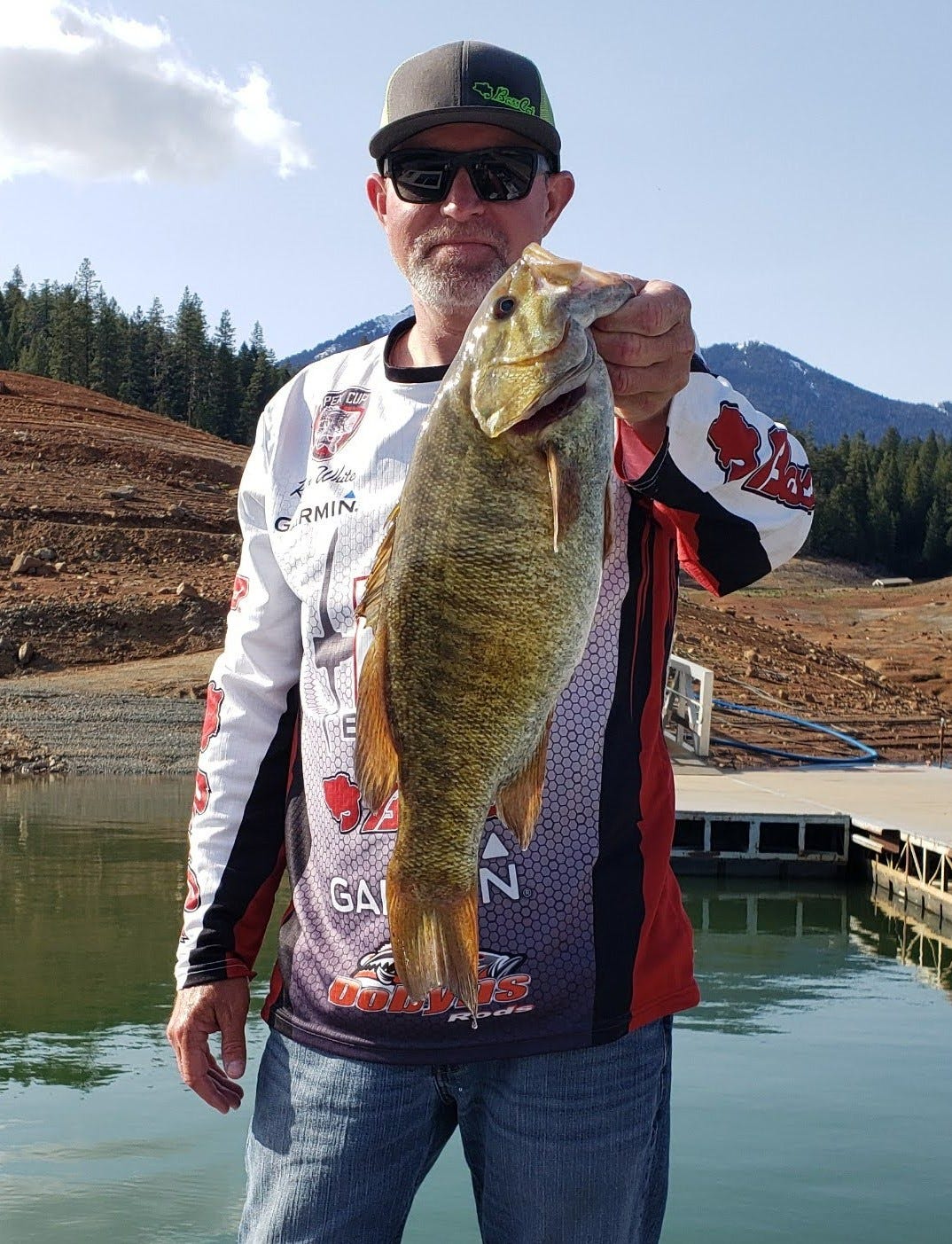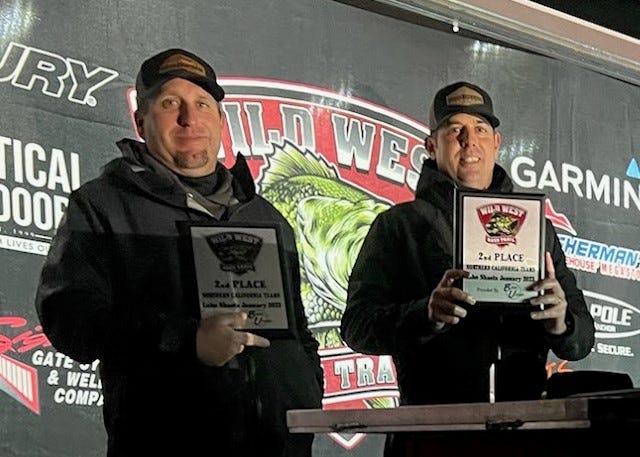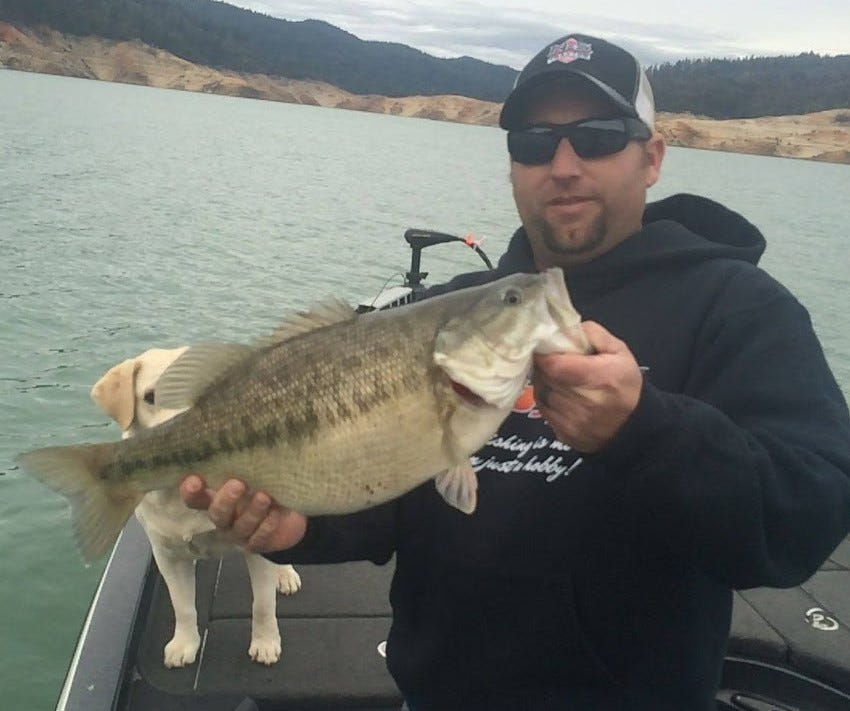Forward-Facing With Your Head Down
Forward-Facing Sonar Units and the ‘Harass-A-Bass’ Technique Have Changed Bass Fishing Forever
The rumors percolated pre-pandemic of an electronics guru devouring the competition in America’s largest crappie tournaments. Fishing in a previously unimagined futuristic manner, from the not-so-bass-mecca state of Oklahoma, Josh Jones is reported to have caught more than 200 ten-pound fish in less than five years. Dobyns Rod owner and bass tournament legend Gary Dobyns first met Josh Jones through a former business partner and two-time national crappie fishing champion, Matt Morgan.
“Gary, you need to meet him and get on a boat with him. I’m telling you right now. He’s the best crappie angler on the planet, and once he transitions to bass, he’s going to catch more big fish than anyone ever has,” Morgan told Dobyns.
I remember those words well because they were virtually identical to what Gary told me in the Winter of 2021. We were fishing California’s Lake Oroville with the first generation of forward-facing sonar, and Gary was trying to show me how to use it. I’ll wait for the western guys to prove me wrong, which is certainly a possibility. But from my limited understanding of this weapon and its primary utility, Lake Oroville might be the second worst body of water on which to use it due to Oroville’s seemingly infinite number of one to two-pound fish. The worst would be shallow delta fishing. But on the deeper river channels in search of stripers – well, that is likely to be a different story.
“Craig, this ain’t it. What you are seeing today is nothing like what Josh does. I can’t do it. It’s going to take years of practice, and then I still may not be able to do it. You have to understand, he’s only really been bass fishing for a year. He’s still learning the game. And he’s already caught more fish over ten pounds than anyone I know!”
I stood behind Gary on the front deck of his boat as he tried to keep the cone of sonar on a larger-than-average fish he spotted on the forward-facing unit. The spotted bass left him in the dust three seconds later.
“Damn it!” Gary yelled for what seemed like the 50th time that day. “I just can’t stay on ‘em. That’s the whole deal. Josh is so good at staying with the fish. He has the trolling motor on max speed, and he is moving. He’s on it, even if that means he has to shoot 90 degrees to the right or left or reverse it 180 degrees. “
“Does he keep the trolling motor on its max when he turns and reverses?” I asked.
“Yes. All the time. He never turns it down, and he never takes his foot off the pedal. You better hold on tight when you stand up there with him, or you’re going swimming. Craig, he might only make 50 casts in a full day on the water. You get him out there, and he’s one hundred percent totally focused on that screen, finding and staying on big fish. Then he just flips his bait in front of the fish and watches how the fish reacts. He can tell immediately if the fish is going to bite. Then he adjusts accordingly.”
As for his choice of bait, Jones began with large flutter spoons before graduating to Alabama Rigs (A-Rigs). In Gary’s first Oklahoma foray with him, Jones was using A-Rigs.
“So, he finds the big one, engages in carnival acrobatics to keep the fish in the cone of his forward-facing sonar, and then just swims an A-Rig in front of it?” I asked.
“Kinda, but he really sort of drop-shots with it.”
“C’mon, man! He’s drop-shotting A-Rigs and catching a higher percentage of ten-pounders than anyone in history?”
“He is, dude! I’d never have believed this if I didn’t see it myself. You need to fish with him. You have to. If we could get Rich (Gary’s son Richard Dobyns) on a plane, I’d pay for both your tickets and send you up to Oklahoma to see it yourself!”
I was still skeptical.
I believed in the results. I saw the pictures and the short videos on Gary’s phone. But did I really want to dabble with a technique that forced me to keep my head down on a twelve-inch screen while running my trolling motor like a tweaker with a firecracker up my ass? I know me. I’m already tech-allured and too enamored with deep offshore fishing. If I put this on my boat, I may never run the bank again.
The Sonar-Whisperer
Today, the cat is all the way out of the bag. You can watch a mind-blowing 90-minute interview Josh gave to Chris and Trait Zaldain on their podcast, here. Josh gives it all away in this interview, and Chris and Trait do a fantastic job of drawing it out of him. Chris traveled to O.H. Ivie a few days before the interview to try and do what Josh does so that he could better interview Jones. Chris openly admits that he previously thought Jones’ style of fishing would not be too tricky on the right lake (open, deeper water with a plethora of big fish). Chris spent days before the interview trying to replicate Josh’s technique.
His assessment? And I’m paraphrasing here – what you do is hard, man! This is not easy at all!
You can watch that for yourself in the podcast. It is great. It is an elite professional basser at the height of his game offering props to a creative genius for mastering a new form of the craft. I’ve never met Josh. I think I spoke to him briefly once, over Gary’s speakerphone, while we struggled to emulate Josh’s technique on the water. I knew just from Gary’s descriptions of him and his friendship with him that I was going to like the guy.
The Zaldain interview does nothing to change that. It just reinforces Josh’s likeability. He gives it all away. He knows that others will eventually become better than him at this game, and he doesn’t care all that much. Plus, as he explains in the interview, Josh is tired of being accused of cheating. So now, he has a video camera running while he fishes, and he makes his most absurd achievements public.
Way back in the mid-20-teens, Josh Jones the cable guy, went to the home of a fellow Oklahoma resident with TV reception issues. Josh fixed the problem, and as a tip for his excellent service, the customer gave Josh a prototype forward-facing sonar unit. The customer, an executive at one of the nation’s largest sonar manufacturers, had the units in his garage and figured if anyone had the technology savvy to hook it up, figure it out, and make it work, it might be this crappie fishing cable guy.
He was right.
As Josh explains to Chris and Trait in their podcast, there were no instructions, no links to videos, nothing. He just had to figure it out.
Nearly a decade later – mission accomplished!
Not convinced? Check out this video of Josh catching five bass that weigh a combined 61.37 pounds. A mere 12.27 pound-per-fish average. Josh guesses he’s caught more than 100 bass over ten pounds, but openly admits that he’s lost track of them.
Gary scoffs at the number and thinks it is probably well over 200.
It’s Not Fishing
I know you won’t believe this, but if you comb social media and the bass fishing forms online, you’ll find both love and vehement hate for what Josh is doing. I know! The internet housing divergent and inanely emotional responses to stuff? Who’d have imagined?
The purist and traditionalist fishermen are, by and large, not big fans of forward-facing sonar and what it is doing to the sport. One day on the boat with a lifelong buddy and artist, Paul Hermann, I described in painstaking detail what Josh was doing and how this technique worked. Paul is a phenomenal artist and goes about things quite differently than I do. I compile data, keep statistics, and log all fishing trips. In my day job, I use the same analytical skills to assess risk for companies. Paul rolls by feel, mood, and experience.
“So, you just find the big fish, and then the most important skill becomes working your foot pedal to stay on it while keeping it on your video screen?” He asked.
“Yeah, that’s it in a nutshell. And the longer you stay on that fish, and the more you piss it off with something as outlandish as an A-Rig in its face, the more likely you are to catch it.”
“So, it’s not seduction. You aren’t alluring the bass with deception and enticement? You are there to provoke it after incessant needling? You harass it until it lashes out? They ought to call it harass-a-bass,” Paul said.
“Wow. Great term, dude. That one is going to stick.”
To be fair, it is so much more than that. It may have started out that way in the early days when Josh began this quest. But now, nearly half of bass boats have this technology and employ it in some way or another. The fish are adapting. It is nowhere near as easy as it was in the beginning. In his interview with the Zaldains, Josh explains that he spent one whole day on a massive school of big fish offshore without getting them to bite, despite his wizardry with the sonar and trolling motor. After throwing everything in his boat at them, he started to use crappie gear out of desperation. It worked. The next day he returned to the school armed with compact swim jigs. He theorized that the smaller nature of the crappie jigs worked. So, Josh trimmed a swim jig down as far as he could so that the skirt only extended to the bend of the hook, and he fished that jig out in front of big fish with no trailer on it.
Boom!
Big fish after big fish fell prey.
As Chris comments in the podcast, “Who does that?!?!”
And he is right. People don’t drop-shot A-Rigs or fish buzzcut trailer-less swim jigs in cold, clear open water. That just isn’t normal. That’s some next-level, front-facing sonar sorcery.
Dobyns Rods, Bass Cat, and P-Line pro, Tony Franceschi of Granite Bay, California, analogizes it to deer hunting for bass. He explains that there has never been a faster way to find concentrations of fish. And when you do find them, you can use the sonar to scan those fish, looking for the biggest one the way a deer hunter might glass the side of a mountain.
“Unless you quit fishing tournaments, you will buy it. I know you will. Without it, you will struggle to be competitive in the cooler months when fish are schooling,” Tony said to me. “And it leans right into the way you like to fish.”
As you must be starting to realize, this is nothing like any fishing you’ve ever done before. On a typical tournament day, an angler might make 1,000 casts. Josh might only make 50. As Tony said, you use the sonar to find concentrations of fish, and then you are hunting for the largest one you can find. Whether you are stalking that single big fish and working to dupe it with your longest, most accurate cast or violently manhandling your trolling motor to stay on that big fish while you incessantly dangle spoons, A-Rigs, and jigs in front of it until it snaps is, I suppose, a matter of opinion, spin, or skill.
Whether we like it or not, bass fishing has made a quantum leap.
Oh, It’s Fishing Alright
Auburn, California Dobyns Rods, and Bass Cat pro, Ryan White defends the tech as strongly as I’ve heard.
“It’s here. We aren’t going back. Guys are just going to have to adapt and learn it. And when they do, they’ll be amazed at the things they learn,” he told me.
My nickname for Ryan is Dark-to-Dark (D2D). He’s one of these folks who is so eaten up with fishing that he can hardly stand to fish for less than a full day. If you plan to fish on Saturday with Ryan, know that you are launching 45 minutes before the sun comes up, and you’ll barely be able to see the dock when you idle in well after sundown. He’s going to grind all day whether we catch 100 or one, both of which we’ve done over the years.
I spent a day with D2D on a smaller California foothill lake known for stud smallmouth and fat largemouth. It’s one of very few in northern California that’s not yet been overrun with spotted bass. It was a tough day. We only put a dozen fish in the boat, ten of which he caught. Had we been on my boat without the forward-facing units, I don’t think we’d have caught more than four or five fish.
There were large swaths of bank devoid of keeper fish. That blew my mind.
“Oh no, dude. We don’t waste time fishing until we find them now. That’s a thing of the past,” he said.
Having fished with D2D most of my adult life, I figured we’d beat the bank with reaction baits for the first one or two hours before we started looking for offshore fish. We were offshore after about five casts.
“Fish aren’t there; they’re out here, see,” he said.
“Yeah, I see,” I said as I was tying on a Senko and a jig. Five casts into the day, there was no need for the cranking and ripping rod.
We spent the whole day out in 40 to 60 feet of water on an offshore ledge and rockpile, that were not marked on the upgraded map chip. The elusive spot on a spot, as bassers call it. And we found it before the sun even finished its ascent.
We did drift over to different parts of the bank from time to time but quickly returned to the deep water as we could see that is where the fish were, particularly the big ones.
The bass behaved like weight-conscious girls before prom. They wouldn’t eat, no matter what we offered them. We saw hundreds of big fish, but it didn’t matter. I’m not sure what is more maddening, having no clue where they are, or seeing them all around you and having virtually no chance to get them to bite. I think the latter might be worse because when you don’t see them ignoring you, you still have the hope of moving to a different part of the lake to “find” fish.
The way this unit has changed Ryan’s fishing style in less than a full year of use boggled my mind. He used to fish with a dozen rods all piled on his deck as he relentlessly switched from one bait to the next to crack the day’s code. He’d switch to bright or dark-colored baits and say, “ya gotta show it to ‘em.” When that didn’t work, he’d go with subtle, natural shades and say, “ya gotta hide it from ‘em.”
When the bite got really tough, he’d downgrade to 5-pound fluorocarbon and a sixteenth-ounce dart head with a four-inch Roboworm and turn to me, place his finger over his lips in a shhh-fashion, and say, “slow fall,” in a quiet librarian’s voice.
But on this day, I noticed he was cannonballing one-ounce jigs. This was before Josh revealed what he was doing with A-Rigs, so I didn’t feel comfortable spilling the beans, so to speak. I wanted to hear D2D’s explanation.
“Dude, forget all that. I don’t even carry that light stuff anymore. You need to get down to the fish fast when you see them, or you’re just wasting time.”
“Really?”
“Yeah, it’s about getting it in their face quickly to see how they react. If they swim over to it and look at it, you are going to catch them. You just have to stay on them. Those are the fish that’ll bite.”
And that’s when it hit me.
That is exactly what Josh Jones says, but he’d not said it quite so publicly at this point, so I knew D2D figured that out on his own, too.
Josh talks about how he can tell what kind of fish it is by its size, location, whether it has a split in its tail, and how it reacts. He explains this in the Zaldain interview. Once you know it is a bass, a massive piece of this puzzle is reading how the fish reacts to your lure to determine if you believe that will be a fish worth burning time on. And as Josh says, that is just something that’s going to take experience for each angler.
So, I would not say this is “not fishing.” Yeah, it is like deer hunting in a way, and I also totally understand Paul’s harass-a-bass term, but it is a sport for sure. It’s just different now. You don’t need to waste time beating bassless banks. You can see them, go to them, very quickly find the sweet spot on the spot, and get to discerning what, if anything, will make them bite. And when they don’t bite, you need to decide whether to employ your best pick-up-artist techniques or to look for a more desperate dance partner.
What Happens to Derbies?
As I said, I’ve not installed it on my boat yet. Maybe I will this year as a 50th birthday present to myself. I’m still not sure. Gary has placed it on both his California and Texas boats.
“Oh, trust me, I’m all mixed up on this thing. I like to beat the bank as much as anyone, and that’s just not how Josh is doing it. He’s out in open water whipping that trolling motor around looking, sometimes for twenty or thirty minutes before he casts. But if a guy wants to compete in tournaments, Craig, I don’t see any other way. There will be events on the California Delta, during the spawn, or on Oroville, where it won’t matter. But over a whole circuit? I think a guy is gonna need it.” Gary explained.
Those using the technology are already seeing the change in the fish. Just like everything else in fishing, the fish learn. Split shotting, rip baits, Senkos, drop-shots, the A-Rig, and now forward-facing sonar. Change is constant. But unlike with new baits or, arrays of baits (A-Rig), forward-facing units aren’t new enticements the fish can decide not to bite. They are tools that allow fishermen to see and stay on the fish.
Most significantly, it allows an angler to fish for bass in the middle of a lake, suspended in forty feet of water over a hundred-foot bottom. Those fish virtually never saw a lure before. Now they can have the harass-a-bass technique place every conceivable lure in an angler’s boat in its face. And the better anglers get at staying on the fish, the more lures the bass will see.
Over the last three years, as we’ve seen more and more anglers employ this technique, fishermen noticed that it is getting harder to get fish to bite. One huge difference Gary points out, “is that the closer you are to the bass, the worse things are. That has always been the case in bass fishing, but the forward-facing units have supercharged that from what I’ve seen. There are times now when you think you are being quiet, and stealthy, and you ease into a cove, and you can see the fish on your screen slide back off the tops of rocks down behind them once they feel your presence. They all duck for cover. Again, this probably always existed, but we didn’t have the technology to see it. But I’m here to tell you; it has gotten worse since I’ve been using the units.”
I asked Gary if he thinks that tournament organizations will outlaw the technology. He winces a little, squints his eyes, and turns his head to the side like he just took a bite of an unripe pear.
“I don’t. It is out there, and guys will want to use it. Plus, the sponsor support from the manufacturers to the tourney orgs is going to be too much to turn down. But I think we might see a place where some of the rookie leagues spring up and think about banning it. I dunno, though; even that will be a tough deal. I just hate that fully loaded glass boats are now $100,000, and guys feel they need to drop $10 to $20K on sonar to compete. It’s not good for the sport.”
I agree with Gary. The units are here, and they will only get clearer and easier to use. Most manufacturers are already on their second or third iteration of the units. Fishermen won’t be able to turn back the clock any more than we can go back to the early nineties and unplug the internet. Fish are adapting and becoming that much warier of boats nearby, especially out in open water where they historically had no serious concerns.
“The Winning Fish Are on the Bank”
Maybe I’m wrong. Maybe guys won’t need these units at all. I’m reminded of a team championship on Lake Berryessa a few years ago. During pre-fish, it was an uncharacteristically difficult bite. I’d retreated to island tops out in the middle of the lake with a drop-shot and Senko. Spot-locked in one place for many minutes at a time, I’d lightly shake, drag and dead-stick my fairy wand.
Richard Dobyns, pulled up and asked me, “how come whenever I see you, you’re way the hell out in the middle of nowhere, spot-locked and fishing off the back seat?”
“’Cause I’m not as good as you. I need to get out here and fish for the less pressured fish. Plus, I’m kinda lazy,” I said with a smirk.
“Gottwals, you may have fun catching them out here, but this isn’t where this tournament will be won. You need to go and catch them up there,” he said, pointing to the bank.
Even though I knew what his answer would be, I asked Rich if he was going to add the forward-facing units on his boat and start to look for big fish before he casts.
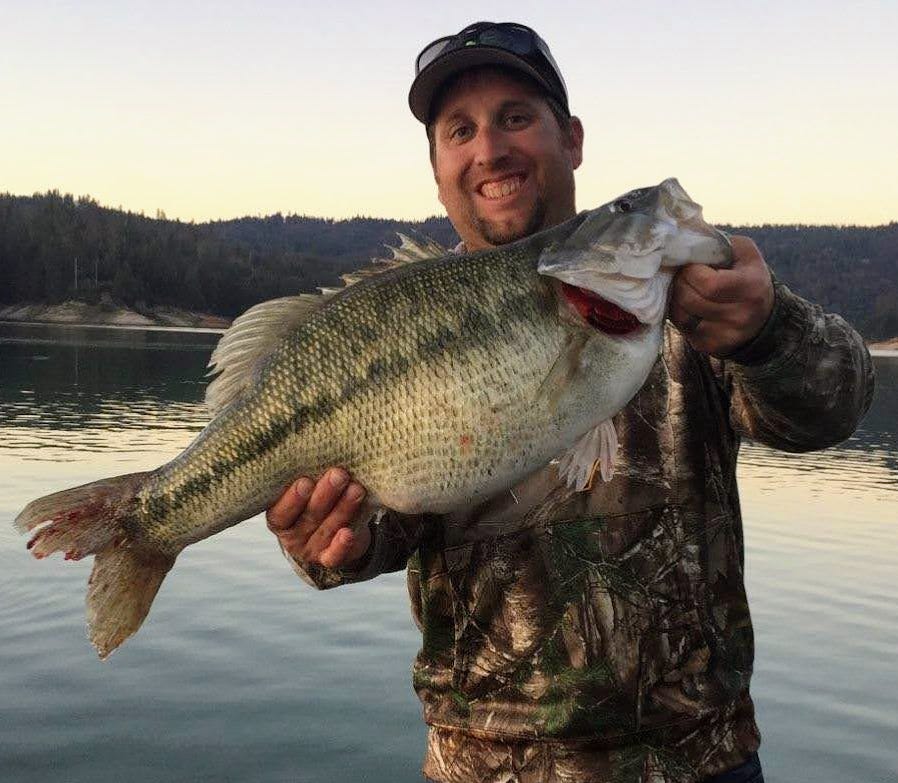
“No way. You know me. If I can’t catch them shallow, then I’m gonna crash and burn. Let these guys educate those fish out there. I’ll get them when they come to the bank.”
Richard admits that there are times when he fishes a bit further offshore with an A-Rig, ripbait, or crankbait. But if he can’t reach shore with a shotgun, it is a rare event.
“I’ve never seen as many people spooning out in the middle of the lake as I saw on Shasta and Oroville in the last two events,” Richard told me. “Good. I love to see those guys out there. Educate those fish and keep the pressure off the bank. I’m going to run my game shallow and let the chips fall where they may.”
It’s working out well so far for Richard this season. In a January event, he and his team partner, James Avalos, finished second out of 109 teams on Lake Shasta. And in February, they finished 31st out of 112 boats on Oroville. In the Oroville event, Richard explains that they had the big bites to win and just didn’t get it done. “We were in the right place. The bites were there. A little bad luck and a little bad execution kept us from the podium, in that event.”
“There are always shallow fish. I don’t care what lake you are on or what time of year. Bass like shallow water, and a guy does not need fifteen grand of sonar to find ‘em. All the stuff we learned, growing up still applies. Yeah, there are times when there are more fish out deep. And those are the times those units will help. But I’m not sold that it’s going to be necessary. I’m not sold at all. You still have to catch them, and the best way to do that is to fish your strength,” Richard concluded.
Maybe he’s right. In fact, I hope he is right. I don’t think that any of us who love the sport like to see the trend of $100,000 boats, $15,000 of sonar units, and $2,000 entry fees where you’d better finish in the top three to make any meaningful profit. Perhaps the best indicator of this is the meteoric growth in the popularity of kayak fishing and the renewed popularity of aluminum boats at a somewhat reduced price.
But as much as I’m rooting for the bank-beaters of the world, deep in my soul, I know things have changed, dramatically. I do think we’ll always have shallow-water savants like Rich out there who can compete without the units, but my gut tells me that will constitute less than twenty percent of any pro event – even in my most optimistic assessment. Once an angler sees harass-a-bass in action, it’s going to be hard to get those images out of his head, even if it’s to see a fish’s negative reaction to his bait.
I know that is what haunts me when I’m not catching them, now. I want to know how many fish are under me. I want to know if they are looking at my presentation bashfully, playing hard to get and ignoring me, or if they are flaring from it like a duck from the shine of a gun barrel.
Harass-a-bass has those answers for you, my friend. And that information is only $10,000 away. As for me, I’m going to wait for what I’m trademarking now as FishLock™. With that tech, your unit will find the largest fish within its 100-foot scannable radius; you will press a button, your trolling motor will stay on that fish, and you can get right to harassin’. You know that must be coming.



